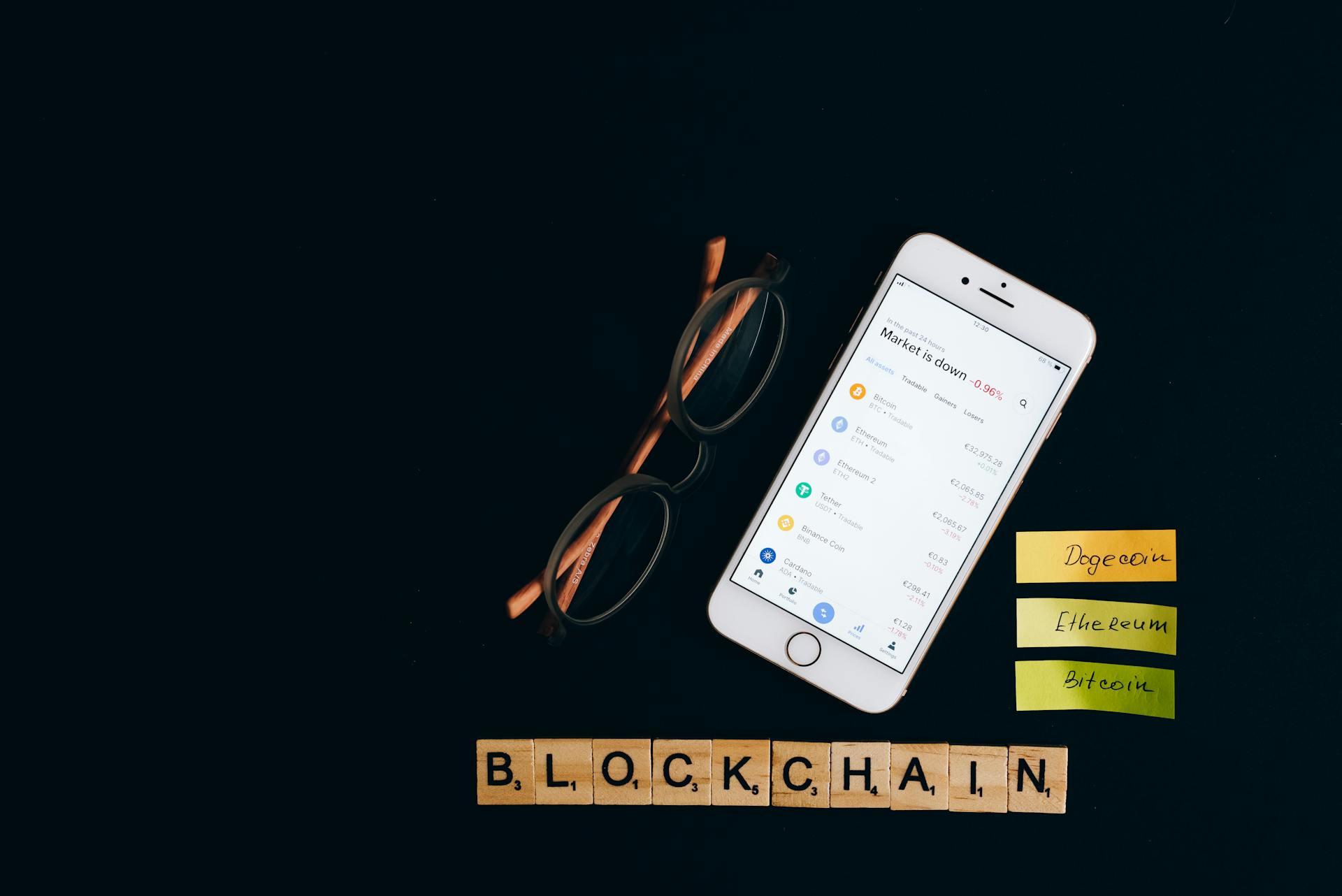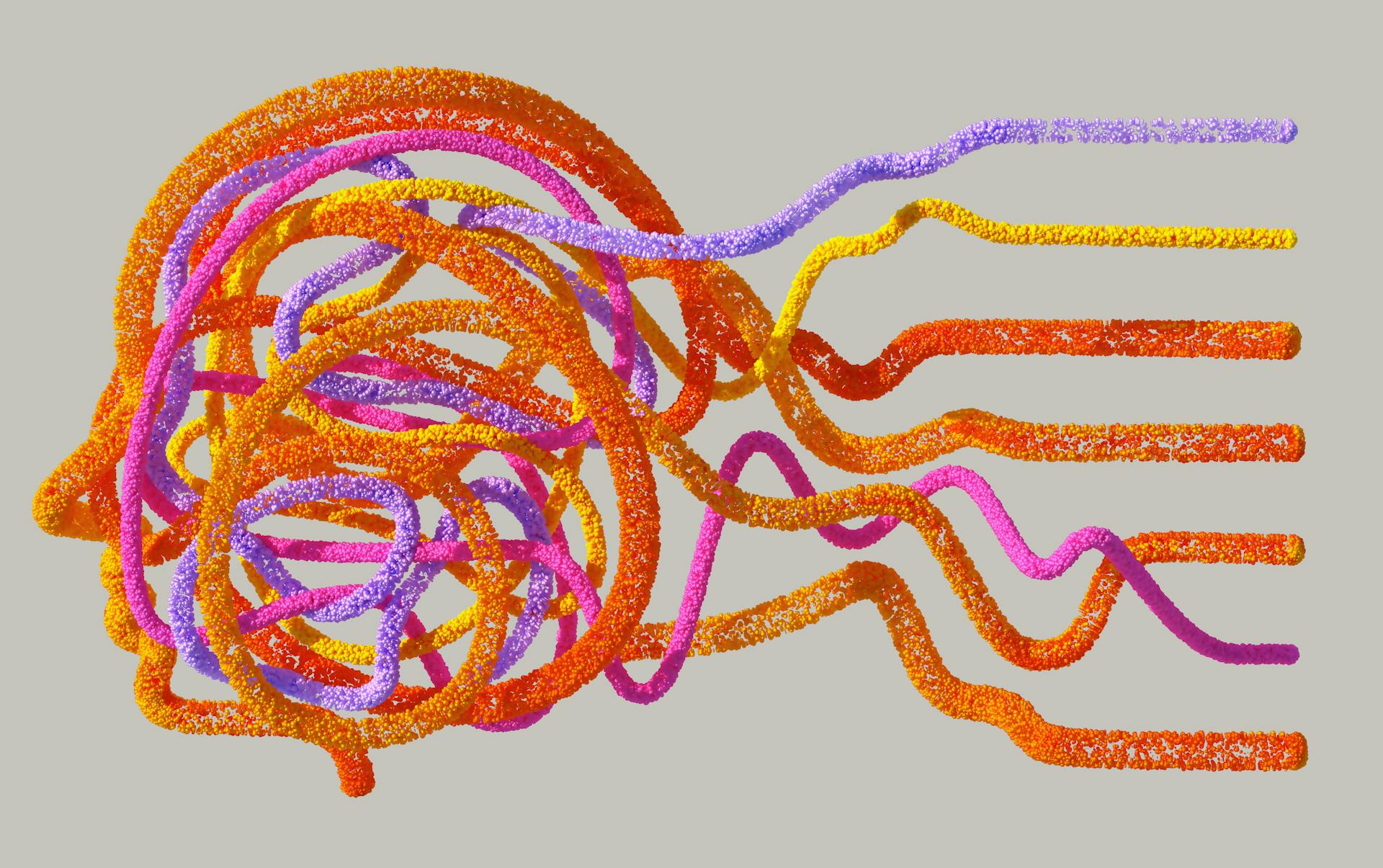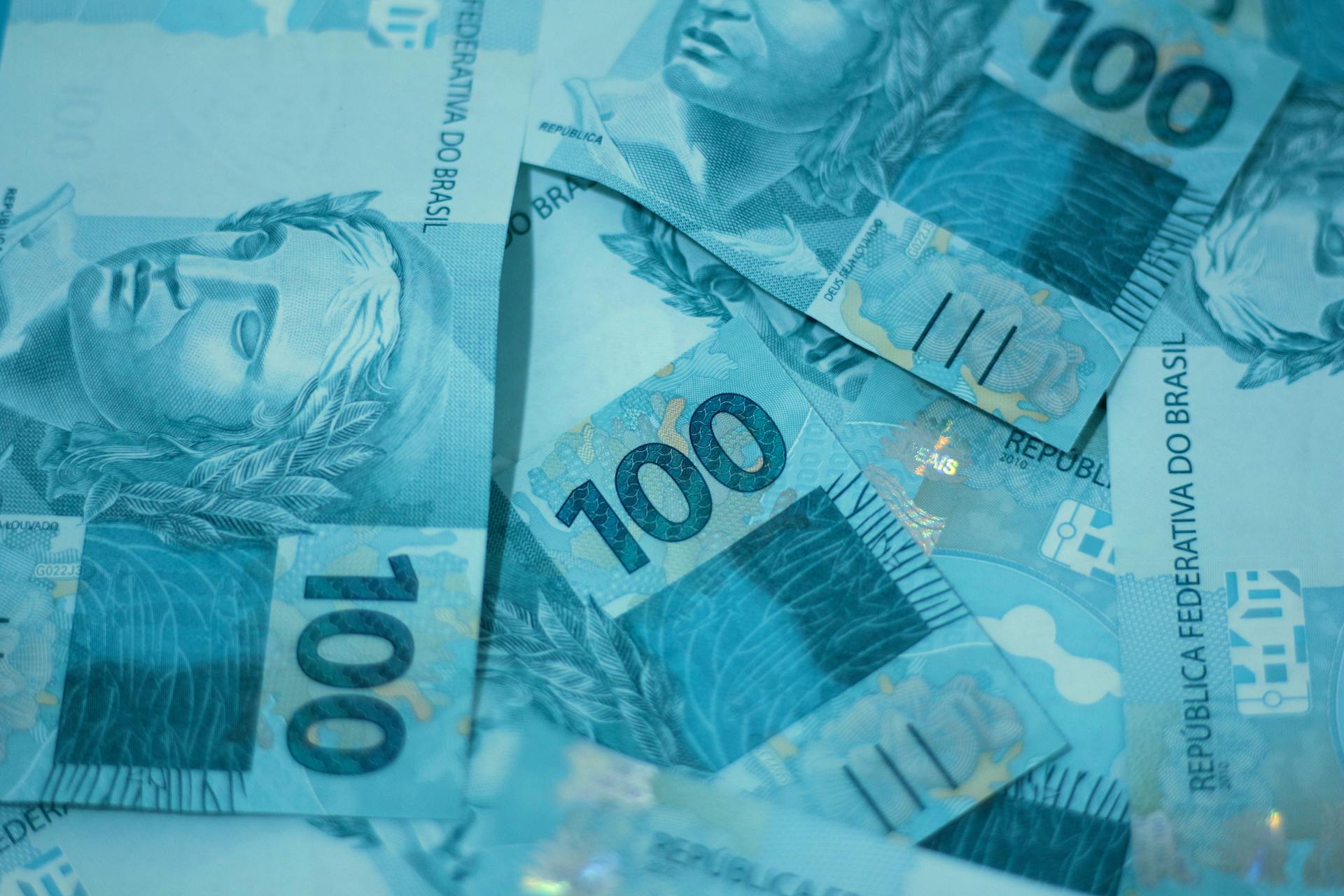
A non-fungible token, or NFT, is a unique digital asset that represents ownership of a specific item or piece of content. These tokens are stored on a blockchain, which ensures their scarcity and authenticity.
NFTs can represent a wide range of items, including digital art, collectibles, and even real-world assets like real estate. This versatility makes them a promising tool for creators and businesses looking to monetize their unique offerings.
Each NFT has a unique identifier, which sets it apart from other tokens. This identifier is stored on the blockchain, making it virtually impossible to duplicate or counterfeit the token.
NFTs have the potential to revolutionize the way we think about ownership and scarcity in the digital world.
For another approach, see: What Is a Digital Asset for Tax Purposes
What Are NFTs?
NFTs are built on a blockchain, similar to how a car title or real estate deed is proof of ownership in the physical world. Most NFTs are based on the Ethereum blockchain network.
NFTs are unique digital assets that can't be directly replaced with another digital asset, making them non-fungible. Real estate is a great example of a non-fungible physical asset, as each property is unique.
An NFT is like a digital certificate of ownership, proving a list of historical ownership and the current owner of a unique digital asset. Code is written into this digital token to make it work.
Many physical assets, like real estate, are non-fungible because each one is unique and can't be exactly replaced with another. Ether is an example of a fungible token, as one Ether is identical to another.
For another approach, see: Non Fungible Token
How They Work
NFTs are traded on decentralized blockchain platforms, primarily Ethereum, which ensures public traceability of ownership while protecting privacy with pseudonyms.
The blockchain's transparency is made possible by the use of smart contracts, which automate the process of assigning ownership during the minting process. Minting involves converting a digital file into a unique digital asset on the blockchain.
Here's how the process works:
- An NFT is created through a digital file, such as an image or video.
- The file is converted into a unique digital asset on the blockchain through a process called minting.
- Smart contracts are used to assign ownership of the NFT to the creator or buyer.
- The NFT is then stored on the blockchain, where it can be bought, sold, or traded.
NFTs can be considered modern-day collectibles, bought and sold solely online with no physical equivalent. They represent digital proof of ownership of any given item.
The owner of an NFT has a digital record of ownership, but it does not necessarily indicate the actual ownership of the physical asset or digital media.
Benefits and Uses
Non-fungible tokens, or NFTs, offer a unique set of benefits and uses that make them an exciting development in the digital world. NFTs allow digital artists to monetize their work directly, without the need for intermediaries like galleries or auction houses.
NFTs provide immutable ownership and authenticity, verified through blockchain technology, giving owners a sense of security and confidence. This is especially important for digital art and collectibles, which can be easily replicated or altered.
Some of the most popular types of NFTs include digital art and collectibles, gaming items, music, and virtual worlds. These NFTs can represent in-game items, characters, or virtual land, and even grant access to exclusive events or experiences.
Recommended read: Monetary Items
Here are some of the key benefits of NFTs:
NFTs have already been used in various ways, including the sale of virtual kittens, trading cards, and even a full studio album by a rock band. As the technology improves, it's likely that NFTs will become even more mainstream and accessible to a wider audience.
Uses and Examples
NFTs are being used in a variety of creative and innovative ways. Digital artists can tokenize their work as NFTs, establishing verifiable ownership and allowing them to monetize their art directly.
NFTs can represent in-game items, characters, or virtual land, appealing to gamers interested in obtaining rare items or collecting memorabilia. This can also be viewed outside of the game, even if the game is shut down.
The music industry can also benefit from NFTs, providing artists with a new way to monetize their work and retain ownership over their music, concert tickets, and merchandise. NFTs can also allow artists to earn passive income through royalty-sharing mechanisms.
If this caught your attention, see: Blockchain Game Market

Some examples of NFTs include:
- National Basketball Association virtual trading cards.
- Digital sneakers from Nike.
- Trading cards featuring personal memorabilia from actor William Shatner.
- A full studio album by rock band Kings of Leon.
- The original Nyan Cat meme.
- Collectible virtual characters called CryptoPunks.
- A variety of GIFs and images commissioned by Taco Bell.
- Virtual real estate in Decentraland, a 3D virtual reality (VR) platform.
- Tokenized real-world assets, such as real estate.
These examples demonstrate the versatility and potential of NFTs in various industries and applications.
Community Building
NFTs can be a powerful tool for building a community around your brand. By offering unique benefits to holders, you can foster a more active community where creators can directly interact with their fans.
Fashion brand Dolce & Gabbana's 'Collezione Genesi' NFT collection is a great example of this. It allowed participants to purchase unique virtual fashion designs that could be digitally superimposed onto images and videos.
NFTs can also serve as innovative reward programs. Starbucks launched a limited-edition NFT collection of 2,000 unique Siren pieces on the Polygon network in 2023.
Holders of these NFTs gained access to an exclusive rewards program featuring exclusive digital content, rewards, and live events. This shows how NFTs can be used to create a sense of FOMO (fear of missing out) and encourage engagement.
Worth a look: Animoca Brand Unicorn
Investing in NFTs
Investing in NFTs can be done publicly through NFT marketplaces and some cryptocurrency exchanges, or privately through brokers and dealers.
Some popular online NFT marketplaces require owning a specific blockchain's native token to buy an NFT, usually in ether, the cryptocurrency of the Ethereum platform.
Buying an NFT can be a high-risk move, as the value of NFTs fluctuates significantly, similar to cryptocurrencies.
Readers also liked: What Is a Token in Cryptocurrency
Beginner Investing
You can buy NFTs publicly through marketplaces and some cryptocurrency exchanges, or privately through brokers and dealers, including auction houses like Sotheby's and Christie's.
To buy an NFT on some online marketplaces, you'll need to own the native token of the blockchain they're on, usually ether, the cryptocurrency of the Ethereum platform.
Many online marketplaces, such as OpenSea and Rarible, require you to own a specific blockchain's native token to make a purchase.
NBA Top Shot, Super Rare, and Nifty Gateway are examples of online marketplaces that follow this requirement.
For your interest: Does Chainlink Have Its Own Blockchain
Investing in Games
Investing in NFT games is a trend worth exploring. Play the market for NFT games, an increasingly popular trend.
NFT games are gaining traction, offering a unique experience for players. They're often built on blockchain technology, which ensures transparency and security.
Investors can participate in NFT games by buying and selling in-game assets, such as characters or items. This can be a lucrative opportunity, but it's essential to do your research.
The NFT game market is still relatively new, but it's growing rapidly. This means there's potential for high returns, but also a higher risk of losses.
Investing in NFT games can be a fun and engaging way to participate in the NFT market. Just remember to set a budget and don't invest more than you can afford to lose.
Explore further: Which Is Traded in a Currency Exchange Market
Volatility
Investing in NFTs can be a thrilling experience, but it's essential to understand the risks involved. NFTs are highly speculative assets, and their value can fluctuate significantly.
Some investors have made thousands or millions of dollars selling NFTs, but others have lost a lot of money on worthless digital assets. The value of an NFT is determined by market speculation and supply and demand, making it difficult to predict.
Unlike assets tied to tangible goods like gold or the US dollar, NFTs have no inherent value. Their value is purely based on what others are willing to pay for them.
The lack of standardization in assessing NFT value makes it hard to compare them. This can lead to some NFTs being overvalued or undervalued, making it a challenging market to navigate.
Importance and Impact
Non-fungible tokens, or NFTs, have become a significant form of alternative investment, appealing to buyers' personal interests and passions. They allow individuals to buy and sell digital assets in new ways, helping artists and content creators display their skills digitally.
The NFT market was valued at $20.44 billion in 2022 and is expected to grow to $211.72 billion by 2030, according to Grand View Research. This growth is driven by the improved ease of onboarding, speculative nature, and grassroots communities developed around NFTs.
NFTs provide a unique opportunity for individuals to invest in things they have a personal connection with, such as digital art, music, or video. The value of an NFT can increase over time, just like any other investment, and is subject to shifts in supply and demand.
Token Importance
NFTs are a significant form of alternative investment that appeals to buyers' personal interests and passions.
The NFT market was valued at $20.44 billion in 2022 and is expected to grow to $211.72 billion by 2030, according to Grand View Research.
NFTs are unique, making them a highly speculative class of investment that should probably be avoided for the average investor.
Environmental Impact
The environmental impact of NFTs is a significant concern. The creation, storage, and trading of NFTs heavily contribute to electronic waste and high energy consumption, similar to bitcoin mining.
The energy consumption required for NFTs is substantial, relying on energy-intensive systems like the Interplanetary File System (IPFS). This has a direct impact on the environment.
The number of NFTs continues to grow, which means so will the energy consumption. This is a pressing issue that needs to be addressed.
E-waste comes from the outdated or broken specialized hardware needed to run the NFT marketplace. These machines contain toxic materials like mercury, lead, and cadmium.

Recycling outdated or damaged computers can help reduce electronic waste and decrease the energy consumption required for manufacturing new devices. This is a simple yet effective way to mitigate the environmental impact of NFTs.
The NFT community has shifted efforts toward sustainability initiatives and developing more energy-efficient blockchain technologies, such as systems that use renewable energy sources instead of fossil fuels.
Creating and Selling NFTs
Creating and selling NFTs can be a game-changer for creators. Smart contracts allow creators to define specific terms and conditions for NFT ownership, fostering transparency and eliminating the need for intermediaries.
Creators can share their works online without the risk of theft or forgery and set their own terms of sale. This empowers them to sell digital art that might not have much of a market, and get paid fees for each subsequent sale of the art.
NFTs are created using smart contracts, which are stored on blockchain and determine the NFT's qualities, such as ownership and transferability.
Check this out: Cryptocurrency Token Sale
How to Make
To make an NFT, you'll need to use smart contracts, which are a crucial feature of blockchain technology. Smart contracts are essentially lines of code that contain the terms and conditions of an agreement.
You can choose from various blockchain technologies, such as Ethereum, Tron, or Neo, to store your NFT. Each blockchain has its own unique features and benefits.
The smart contract code is incorporated into the token when it's created or minted, and it determines the NFT's qualities, such as ownership and transferability. This code is stored on the blockchain, providing proof of ownership and verifiable originality.
Only one person can own the particular token that authenticates ownership of the NFT, even if there are other copies of the same content. This is because each NFT is linked to a single token stored in a smart contract.
A fresh viewpoint: Can a Trust Own an Abele Account
Creator Empowerment
Creator Empowerment is a game-changer for artists and creators. By offering fractional ownership of their creations, similar to stocks and bonds, creators can democratize access to their work and enable fans to participate in their success.
NFTs provide a seamless way to sell digital art that might not have much of a market. Subscription-based models can also provide a reliable source of income for creators and exclusive content for dedicated supporters.
Smart contracts allow creators to define specific terms and conditions for NFT ownership, fostering transparency and eliminating the need for intermediaries. This empowers creators to share their works online without the risk of theft or forgery.
For creators, NFTs create a way to get paid fees for each subsequent sale of the art. This means creators can benefit from their work even after the initial sale.
The Future of
An NFT is only as valuable as what others are willing to pay for it, so it's essential to watch closely as the market evolves.
The value of an NFT is determined by its perceived utility value, which will happen once owners view it as a uniquely valuable experience or feature.
If this caught your attention, see: Things of Value Owned by a Firm Are Called Its
Collectors and investors should view previous and similar sales on established marketplaces to understand NFT value.
NFTs' long-term viability will depend on how their utility value is perceived, and NFT communities will develop and grow, helping to maintain prices and markets; this will increase trust in their long-term survival.
NFTs are linked to future uses in the metaverse, the VR world, and healthcare.
NFTs could be used to protect patient data in healthcare by proving immutable ownership of an asset.
Retailers have begun using NFTs to sell digital products in the metaverse and prove ownership of digital deeds.
NFTs are one of the new uses of blockchain technology, and it's essential to learn the difference between NFTs and cryptocurrency.
Frequently Asked Questions
Why would anyone buy an NFT?
People buy NFTs for their unique value, rarity, and exclusivity, such as one-of-a-kind digital art or historic items. NFTs also provide artists with more control and connection with their fans.
Sources
- https://www.law.cornell.edu/wex/non-fungible_token_%28nft%29
- https://www.investopedia.com/pros-and-cons-of-investing-in-nfts-5220290
- https://www.businessinsider.com/personal-finance/investing/nft-meaning
- https://www.fool.com/investing/stock-market/market-sectors/financials/non-fungible-tokens/
- https://www.techtarget.com/whatis/definition/nonfungible-token-NFT
Featured Images: pexels.com


